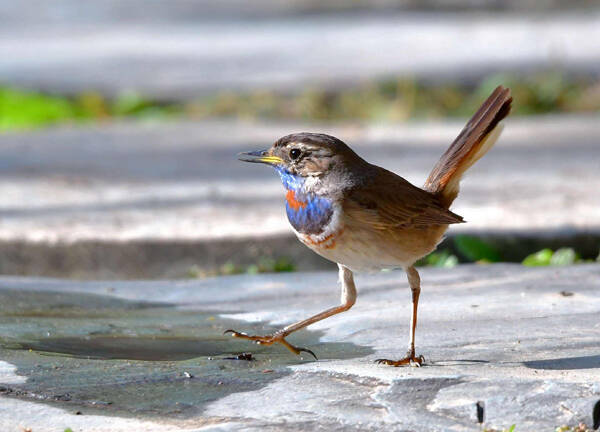Luscinia svecica
IUCN
LCBasic Information
Scientific classification
- name:Luscinia svecica
- Scientific Name:Luscinia svecica,Bluethroat,Bluethroat, Bluegrass, Bluethroat, Bluethroat, Blue-throated
- Outline:Songbird
- Family:Passeriformes Flycatchers S.Robin
Vital signs
- length:12-16cm
- Weight:13-22g
- lifetime:About 10 years
Feature
The chin and throat are brilliant blue, with black horizontal stripes underneath
Distribution and Habitat
Distributed in Afghanistan, Albania, Algeria, Armenia, Austria, Azerbaijan, Bahrain, Belarus, Belgium, Benin, Bosnia and Herzegovina, Bulgaria, Burkina Faso, Cambodia, Canada, Chad, China, Croatia, Cyprus, Czech Republic, Denmark, Egypt, Eritrea, Estonia, Ethiopia, Finland, France, Georgia, Germany, Ghana, Gibraltar, Greece, Hungary, India, Iran (Islamic Republic of), Iraq, Israel, Italy, Japan, Jordan, Kazakhstan, Kuwait, Lao People's Democratic Republic, Latvia, Lebanon, Libya, Lithuania, Luxembourg, Mali, Malta, Mauritania, Mongolia, Montenegro, Morocco, Myanmar, Nepal, Netherlands, Nigeria, Norway, Oman, Pakistan, Palestine, Poland, Portugal, Qatar, Romania, Saudi Arabia, Senegal, Serbia, Slovakia, Slovenia, Spain (Canary Islands) , Sri Lanka, Sudan, Sweden, Switzerland, Syrian Arab Republic, Tajikistan, Thailand, Tunisia, Turkey, Turkmenistan, Ukraine, United Arab Emirates, United Kingdom, United States (Georgia), Uzbekistan, Vietnam, Yemen.
Migrant bird: Bhutan, Cote d�
Appearance
The male blue-throated thrush has earthy brown upper body feathers, darker feathers on the head with white eyebrows, bright blue chin and throat with chestnut spots in the center, black horizontal stripes and two wide bands of light chestnut under the chest, white abdomen, brownish white flanks and undertail coverts. The tail feathers are dark brown with chestnut red at the base.
The female bird is very similar to the male bird, but the chin and throat are brownish white, there is no chestnut spot on the throat, the throat is white without orange and blue, and the black thin cheek stripes are connected to the chest band composed of black spots. The difference between the female red-throated thrush and the black-breasted thrush is the different spots on the tail.
The wing coverts of the young bird have light chestnut spots and light spots, commonly known as "wing spots".
The iris is dark brown. The bill is black. The feet are brown.
The subspecies differ in the siz
Details
Bluethroat, also known as Bluethroat in English, has 10 subspecies.

Bluethroat is timid and often runs short distances underground, stopping for a while, twisting or spreading its tail feathers from time to time. It likes to hide under reeds or low bushes, flying very low, usually only for short distances. It often jumps happily and runs very fast on the ground. It usually sings in a single tone, and in the breeding season it makes a loud and beautiful song, and can also imitate the sound of insects.
The blue-throated thrush mainly feeds on beetles, stink bugs, locusts, Lepidoptera, Coleoptera and other insects and insect larvae, especially Lepidoptera larvae. It also eats plant seeds, etc.
The breeding season of the blue-throated thrush is from May to July. It usually nests in bushes or pits on the ground, and also nests in tree roots and caves on riverbank cliffs. The nest is well concealed. It is made of materials such as dead grass stems, dead grass roots, and leaves. The bottom of the nest is covered with fine grass stems and grass leaves, and sometimes animal hair and feathers are placed. There are 4-7 eggs in the nest. The eggs are light green or gray-green, with brown spots, patches or stains, especially the spots at the blunt end are denser and larger, and the spots or patches at the tip are small and sparse. The size of the egg is 17-21 mm × 13-15 mm. The female bird is responsible for incubation, and the incubation period is 13-15 days. The chicks are late-maturing. After hatching, they are fed by both male and female parents. After 14-15 days of feeding, the chicks can leave the nest.
Listed in the "Nationally Protected Land Wild Birds with Important Economic and Scientific Research Value" issued by the State Forestry Administration of China on August 1, 2000.
Listed in the 2013 Red List of Endangered Species of the World Conservation Union (IUCN) ver 3.1 - Low Risk (LC).
Listed in the second level of the "List of National Key Protected Wildlife in China".
Protect wildlife and eliminate game.
Maintaining ecological balance is everyone's responsibility!








